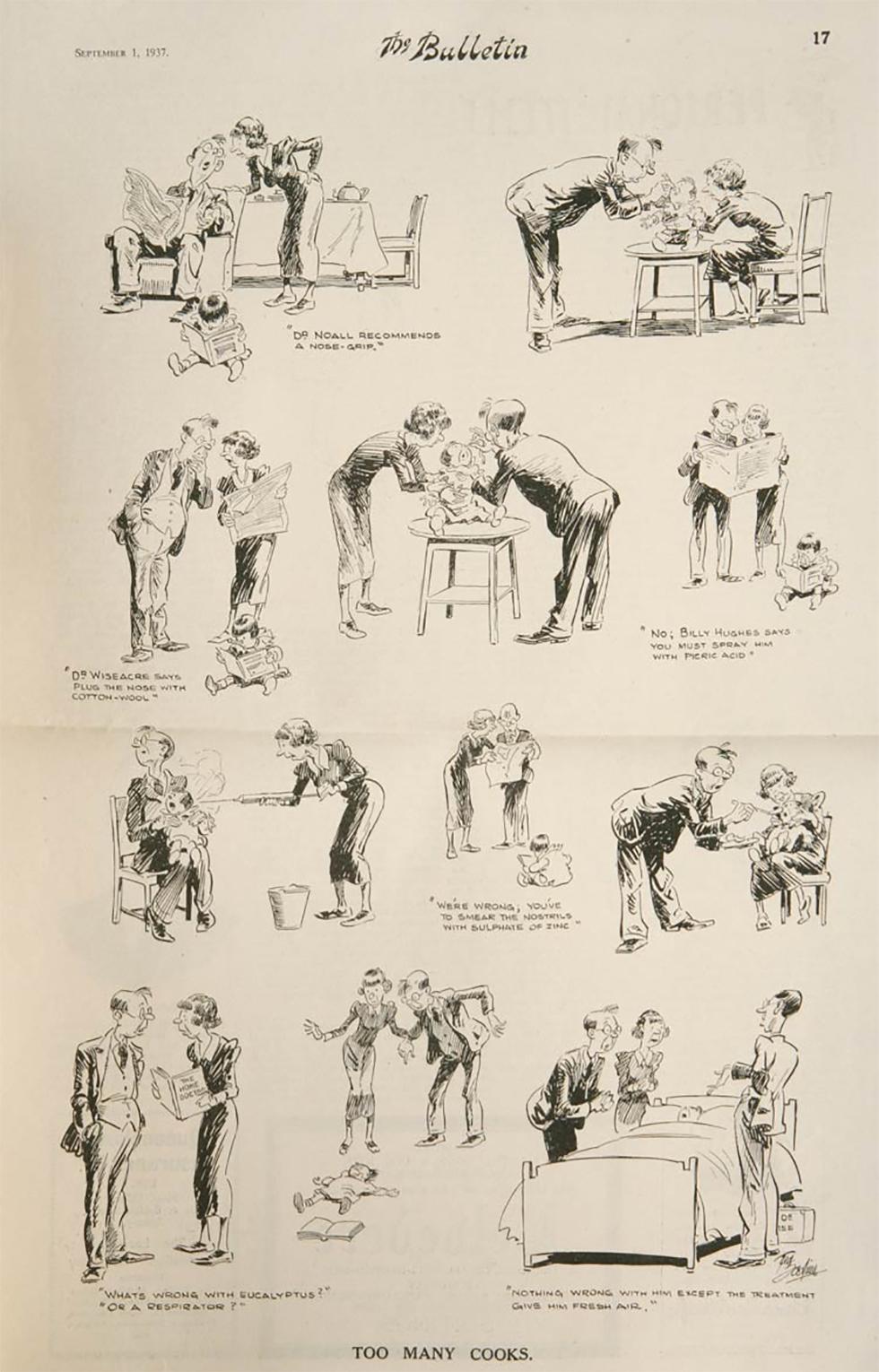


Transcript
[Header reads 'September 1, 1917', 'The Bulletin', '17']
[A series of images of a man, a woman, and a small child, alternating between the adults reading about a treatment in a newspaper, and the adults applying that treatment to the child. The child looks uncomfortable in each image of the treatment, and after the final one, lies on their back on the ground.]
"DR NOALL RECOMMENDS A NOSE-GRIP"
"DR WISEACRE SAYS PLUG THE NOSE WITH COTTON WOOL"
"NO; BILLY HUGHES SAYS YOU MUST SPRAY HIM WITH PICRIC ACID"
"WE'RE WRONG, YOU’VE TO SMEAR THE NOSTRILS WITH SULPHATE OF ZINC"
"WHAT'S WRONG WITH EUCALYPTUS?" "OR A RESPIRATOR?"
[In the final cartoon, the child is lying in bed, with his parents standing on one side, and a doctor on the other side. The doctor says:]
"NOTHING WRONG WITH HIM EXCEPT THE TREATMENT. GIVE HIM FRESH AIR."
[The page as a whole is captioned:] TOO MANY COOKS
About this record
This is a black-and-white cartoon commenting on the various methods of treating influenza used in the 1930s. It depicts parents reading books and newspapers and taking the advice of doctors and of William Hughes, the then Minister for Health, in an attempt to find the best treatment for their child's illness. The cartoon ends by suggesting that the treatments were doing more harm than good and that fresh air would be better than all the remedies the parents tried. The cartoon was published in the Bulletin in 1937.
Educational value
- The cartoon humorously presents the serious issue of the struggle to find an effective remedy for influenza in the 1930s. During the 1930s a slow-mutating form of the 1918 Spanish flu virus was isolated, but virology was then in its infancy. The remedies people relied on at the time were largely ineffective in dealing with the influenza virus – including measures such as barriers (zinc sulphate), germicides (picric acid) and fresh air, as indicated in the cartoon.
- Influenza is an acute viral respiratory infection affecting humans, horses, pigs and birds. It is highly infectious to humans, and epidemics in European populations have been recorded since the early 16th century. Pandemics have occurred several times each century since 1700. There are three main types of influenza virus, each with the capacity to mutate to new forms. Immunisation must be tailored to the particular strain present in the population.
- Most cases of death in people with influenza are not caused by the influenza virus but rather by complications such as pneumonia due to bacterial infections. These can result in considerable morbidity (illness and disease) and mortality, particularly in children and the elderly and among groups living in close quarters. Today influenza can be treated with antibiotics, but although sulphur-based drugs had become available by 1936, it was not until World War II that penicillin and a range of antibiotics were developed.
- By the time this cartoon appeared there had already been a progressive decline in infectious disease mortality due to improvements in public health, housing, education and sanitation.
- Although the cartoon suggests that existing treatments were not understood or successful, research into the influenza virus – pioneered in the 1930s by Sir Macfarlane Burnet and his group at the Walter and Eliza Hall Institute in Melbourne – would soon revolutionise disease control. Burnet’s team helped to isolate the first known viruses causing human influenza and other eminent Australians have subsequently made major discoveries in a range of related areas.
Acknowledgments
Learning resource text © Education Services Australia Limited and the National Archives of Australia 2010.
Related themes
Need help with your research?
Learn how to interpret primary sources, use our collection and more.


